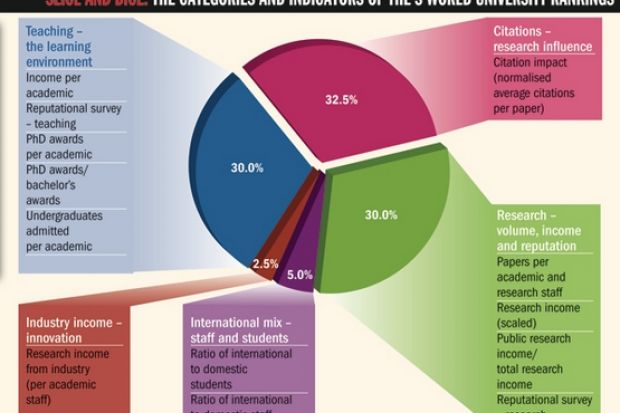The seventh annual Times Higher Education World University Rankings will be published on 16 September – find out more at the new home of World University Rankings.
The date was announced in London this week as further details were revealed of the rankings' new methodology.
Following almost 10 months of intensive consultation, and after detailed input from an expert advisory group of more than 50 international higher education leaders, THE confirmed that it will use 13 individual performance indicators, combined under five broad categories, to create its new rankings.
"The indicators we have chosen will ensure not only that our rankings are the most comprehensive and sophisticated available, but that they will also be the only global rankings that cover all three core missions of a university: teaching, research and knowledge transfer," said Ann Mroz, editor of THE.
"While there is still a very strong set of indicators of research quality, which are essential as nations make cutting-edge research central to their economic strategies, we have also put unprecedented effort into examining institutions' teaching environments."
A new broad category, called "Teaching - the learning environment", will be given a weighting of 30 per cent.
Using five separate indicators, this category will use data on an institution's income, staff-student ratios and undergraduate-postgraduate mix, as well as the results of the first-ever global academic reputation survey examining the quality of teaching.
A further 30 per cent of the final rankings score will be based on another new indicator, "Research - volume, income and reputation".
This category will use four separate indicators, including data on research income, research output (measured by publications in leading peer-reviewed journals) and the results of the academic reputation survey relating to research.
The highest-weighted category is "Citations - research influence".
This category will examine a university's research influence, measured by the number of times its published work is cited in other academics' papers.
Based on the 12,000 journals indexed by Thomson Reuters' Web of Science, and taken over a five-year period, the citations data will be normalised to take account of different volumes of citations between disciplines.
Reflecting the high levels of correlation between citations data and research excellence, this category will be given a weighting of 32.5 per cent.
A fourth category, "International mix - staff and students", will use data on the proportion of international staff and students on campus. This indicator will be given a 5 per cent weighting.
Knowledge transfer activities will be reflected in "Industry income - innovation", a new category worth 2.5 per cent of the total rankings score. This will be based on just one measure in 2010 - research income from industry.
Ms Mroz said the methodology "takes a radical new approach that builds on seven years' experience in the rankings business, backed by the wide pool of global expertise to which we have access. The major changes we've made will mean that the rankings will set the global agenda more than ever before.
"We will give the most accurate picture yet of the global higher education hierarchy at a time of extraordinary change."
For the latest World University Rankings news, debate and social networking, see www.timeshighereducation.co.uk/worlduniversityrankings2010.
Register to continue
Why register?
- Registration is free and only takes a moment
- Once registered, you can read 3 articles a month
- Sign up for our newsletter
Subscribe
Or subscribe for unlimited access to:
- Unlimited access to news, views, insights & reviews
- Digital editions
- Digital access to THE’s university and college rankings analysis
Already registered or a current subscriber? Login
